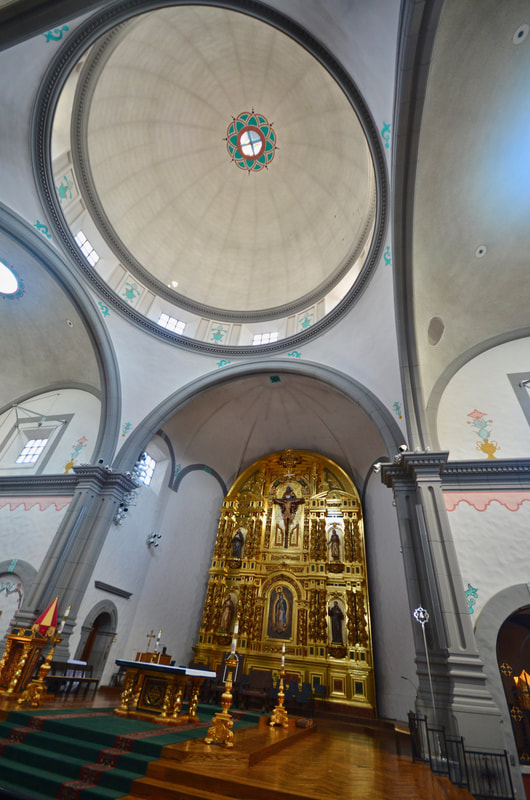96. SAN JUAN CAPISTRANO
The Home of the Missing Swallows from Argentina
|
By Miguel Pérez
Internationally, Mission San Juan Capistrano is known as the seasonal home of the swallows. But not just any swallows! These are undocumented immigrants who come flying across the border every year, all the way from Argentina! Hundreds of swallows normally showed up around March 19 and stayed through the summer. But unfortunately, most of them have stopped coming! People here believe that human urban development has driven the birds away from their natural nesting habitats. But I say it has something to do with our anti-immigrant rhetoric. (LOL) They have been spooked by our xenophobia! Nevertheless, there have been many efforts to convince the swallows to return - with recordings of singing swallows over loudspeakers and even fake nests to save the birds the time and energy required to build one. But it has been mostly in vain. On this page, check out the ABC-TV video report on the Capistrano Swallows from June 19, 2017. When the Great Hispanic American History Tour, arrived in this beautiful city, the first thing that became obvious was poor planning. I had not allotted enough time to explore the many attractions that deserve our attention here, and I had already booked our tour for other activities the following morning much further north in the Los Angeles area. Mind you, I was cursing myself, because I've seen photos of this particular mission and I was anxious to confirm that this is indeed, as it is known, "The Jewel of the Missions." But as you can see from my photos on this page, all I was able to visit was the church, the Mission Basilica San Juan Capistrano, built in 1958. It was late in the day, and by the time I reached the (separate) mission entrance, it was closed for the day. (Check out the map below to see the church, the quadrangular mission, and the many other attractions we must go back to visit in downtown San Juan Capistrano. When readers have asked me for a copy of my travel itinerary for this California Road Trip, I usually get a good chuckle and then explain that it would be impossible to have any kind of rigid schedule, that if they are going to make this trip, instead of an itinerary, what they will need is flexibility. So this is one time when I didn't follow my own advice. I was not flexible enough. I had already booked a hotel room for the next two nights in the Los Angeles area, and made plans to visit attractions there the following morning. And so, the Great Hispanic American History Tour is making a list of California sites we must return to visit, and San Juan Capistrano is now on top, preferably around March 19, when the swallows could also by flying there. Besides, even if the swallows don't show up, they always have a huge Mexican fiesta to receive them anyway. For now, we should note that San Juan Capistrano, named after the 15th century Italian "warrior priest," St. Giovanni da Capistrano, was the 7th of California's 21 Spanish missions. Its location was chosen because it was a good halfway point to build a mission between the already existing missions at San Diego to the south and San Gabriel to the north. Curiously, it was founded twice, first by Father Fermín Lasuén in 1775 and again by Father Junípero Serra in 1776. That's because following its initial opening, all missionaries were recalled to the San Diego Presidio because Mission San Diego de Alcalá had been attacked by Native Americans and a priest had been killed. The Great Hispanic American History Tour already took note of the martyrdom of Padre Luis Jayme when we stopped at San Diego de Alcalá a few weeks ago. Yet once the missionaries felt it was safe to return, Serra founded Mission San Juan Capistrano for a second time. Among the things we missed seeing in the mission is the only chapel still standing where Father Serra is known to have said Mass, and the oldest California building still in use. It is known as the "Serra Chapel." It was the Acjachemen peoples who lived in this area, but once they joined the mission and accepted Catholicism, they became Juaneños. Records from 1796 reveal that, 20 years after its establishment, the mission was quite successful, with nearly 1,000 Juaneños living in or near the mission compound and working on the many trades they had learned from Franciscan missionaries. And by 1847, record shows that 4,639 natives had converted. Another huge attraction here is the ruins of its "Great Stone Church," the only California mission chapel not built out of adobe and destroyed by an 1812 earthquake. And those who come to California because of its wineries should know that the "Mission Grape" or "Criolla" was first planted here in 1779, that the state's first winery was build here, and the first California wine was produced in Mission San Juan Capistrano in 1783. There is a lot more to see in this mission and in this town. And for those who can't wait for our tour to return, I understand. So I invite you to visit their beautiful website. On their history page, I particularly like how they explain that, "Unlike the British colonies on the East Coast of North America, who brought people from their homeland to form colonies, the Spanish believed they could transform the Native peoples into good Spanish citizens" who would build their own mission colonies. Check out: missionsjc.com/about/history/ |
En Español:
|
|
Next,
The Great Hispanic American History Tour visits Mission San Gabriel Arcangel - nine miles east of Los Angeles - with plenty of time to enjoy its beautiful gardens and amazing history. Stay tuned! |
























